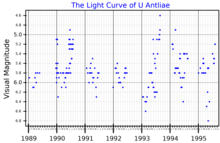
U Antliae (U Ant) is a variable star in the constellation Antlia. It is a carbon star surrounded by two thin shells of dust.
U Antliae is an extremely red C-type carbon star. These cool stars on the asymptotic giant branch are further reddened by strong mass loss and dust that forms around the star. U Antliae is calculated to have an effective surface temperature of 2,800 K, although the light that reaches us has an appearance more like that from a black body with a temperature of 2,300 K surrounded by dust at a temperature of 72 K.[13] It emits most of its radiation in the infrared and although it is only about 500 times brighter than the sun at visual wavelengths,[9] its bolometric luminosity is 8,000 times higher than the Sun's.[13]

In 1901, Louisa Dennison Wells discovered that the brightness of the star varied, from the examination of photographic plates.[15] Annie Jump Cannon included the star, with its variable star designation U Antiliae, in her 1907 Second Catalogue of Variable Stars.[16] U Antliae is an irregular variable star with an apparent magnitude that varies between 5.27 and 6.04. Approximately 900 light years from Earth, it is surrounded by two shells of dust, thought to have been ejected 14,000 and 10,000 years ago.[17] The exact origin and structure of the shells is uncertain, possibly due to enhanced mass loss during thermal pulses, possibly due to interaction of the stellar wind with interstellar material.[13]
References
- ^ Anderson, E.; Francis, Ch. (2012). "XHIP: An extended hipparcos compilation". Astronomy Letters. 38 (5): 331. arXiv:1108.4971. Bibcode:2012AstL...38..331A. doi:10.1134/S1063773712050015.
- ^ a b c d e Vallenari, A.; et al. (Gaia collaboration) (2023). "Gaia Data Release 3. Summary of the content and survey properties". Astronomy and Astrophysics. 674: A1. arXiv:2208.00211. Bibcode:2023A&A...674A...1G. doi:10.1051/0004-6361/202243940. S2CID 244398875. Gaia DR3 record for this source at VizieR.
- ^ Otero, Sebastian (3 November 2011). "U Antliae". AAVSO Website. American Association of Variable Star Observers. Retrieved 25 July 2014.
- ^ De Mello, A. B.; Lorenz-Martins, S.; De Araújo, F. X.; Bastos Pereira, C.; Codina Landaberry, S. J. (2009). "NSCC—A New Scheme of Classification of C-Rich Stars Devised from Optical and Infrared Observations". The Astrophysical Journal. 705 (2): 1298. arXiv:0910.4086. Bibcode:2009ApJ...705.1298D. doi:10.1088/0004-637X/705/2/1298. S2CID 119275102.
- ^ Yamashita, Y. (1975). "The C-classification of spectra of carbon stars. II". Tokyo. 15: 47. Bibcode:1975AnTok..15...47Y.
- ^ a b Ducati, J. R. (2002). "VizieR Online Data Catalog: Catalogue of Stellar Photometry in Johnson's 11-color system". CDS/ADC Collection of Electronic Catalogues. 2237. Bibcode:2002yCat.2237....0D.
- ^ Samus, N. N.; Durlevich, O. V.; et al. (2009). "VizieR Online Data Catalog: General Catalogue of Variable Stars (Samus+ 2007-2013)". VizieR On-line Data Catalog: B/GCVS. Originally Published in: 2009yCat....102025S. 1. Bibcode:2009yCat....102025S.
- ^ Gontcharov, G. A. (2006). "Pulkovo Compilation of Radial Velocities for 35 495 Hipparcos stars in a common system". Astronomy Letters. 32 (11): 759–771. arXiv:1606.08053. Bibcode:2006AstL...32..759G. doi:10.1134/S1063773706110065. S2CID 119231169.
- ^ a b Alksnis, A.; Balklavs, A.; Dzervitis, U.; Eglitis, I. (1998). "Absolute magnitudes of carbon stars from HIPPARCOS parallaxes". Astronomy and Astrophysics. 338: 209. Bibcode:1998A&A...338..209A.
- ^ a b c Khalatyan, A.; Anders, F.; Chiappini, C.; Queiroz, A. B. A.; Nepal, S.; Dal Ponte, M.; Jordi, C.; Guiglion, G.; Valentini, M.; Torralba Elipe, G.; Steinmetz, M.; Pantaleoni-González, M.; Malhotra, S.; Jiménez-Arranz, Ó.; Enke, H.; Casamiquela, L.; Ardèvol, J. (2024). "Transferring spectroscopic stellar labels to 217 million Gaia DR3 XP stars with SHBoost". Astronomy and Astrophysics. 691: A98. arXiv:2407.06963. Bibcode:2024A&A...691A..98K. doi:10.1051/0004-6361/202451427.
- ^ a b Stassun, Keivan G.; et al. (2019). "The Revised TESS Input Catalog and Candidate Target List". The Astronomical Journal. 158 (4): 138. arXiv:1905.10694. Bibcode:2019AJ....158..138S. doi:10.3847/1538-3881/ab3467.
- ^ Răstău, V.; Mečina, M.; Kerschbaum, F.; Olofsson, H.; Maercker, M.; Drechsler, M.; Strottner, X.; Mulato, L. (2023-12-01). "Extended far-UV emission surrounding asymptotic giant branch stars as seen by GALEX". Astronomy & Astrophysics. 680: A12. arXiv:2310.09056. Bibcode:2023A&A...680A..12R. doi:10.1051/0004-6361/202346120. ISSN 0004-6361.
- ^ a b c Kerschbaum, F.; Ladjal, D.; Ottensamer, R.; Groenewegen, M. A. T.; Mecina, M.; Blommaert, J. A. D. L.; Baumann, B.; Decin, L.; Vandenbussche, B.; Waelkens, C.; Posch, T.; Huygen, E.; De Meester, W.; Regibo, S.; Royer, P.; Exter, K.; Jean, C. (2010). "The detached dust shells of AQ Andromedae, U Antliae, and TT Cygni". Astronomy and Astrophysics. 518: L140. arXiv:1005.2689. Bibcode:2010A&A...518L.140K. doi:10.1051/0004-6361/201014633. S2CID 55820070.
- ^ "Download Data". aavso.org. AAVSO. Retrieved 1 October 2021.
- ^ Pickering, E. C.; Colson, H. R.; Fleming, W. P.; Wells, L. D. (April 1901). "Sixty-four new variable stars". Astrophysical Journal. 13: 226–230. Bibcode:1901ApJ....13..226P. doi:10.1086/140808.
- ^ Cannon, Annie J. (1907). "Second catalogue of variable stars". Annals of Harvard College Observatory. 55: 1–94. Bibcode:1907AnHar..55....1C.
- ^ Izumiura, H.; Waters, L. B. F. M.; de Jong, T.; Loup, C.; Bontekoe, Tj. R.; Kester, D. J. M. (1997). "A double dust shell surrounding the carbon star U Antliae". Astronomy and Astrophysics. 323: 449–60. Bibcode:1997A&A...323..449I.









You must be logged in to post a comment.